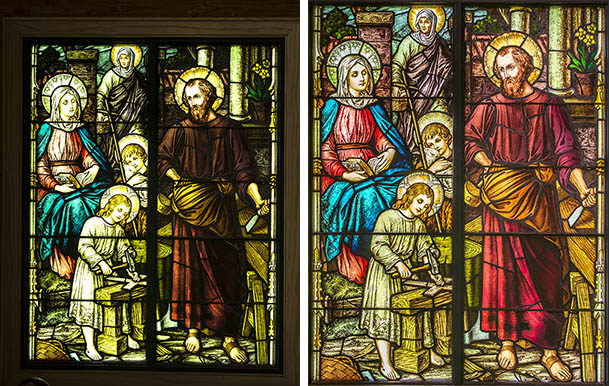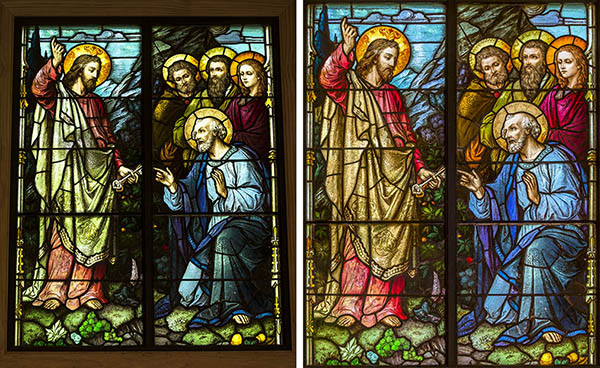Over the weekend I photographed the stained glass windows in a little chapel, and later began thinking it might make an interesting blog post. It is not always easy to recreate the original look of stained glass windows. First of all, they often record with too much contrast. Second, it is almost impossible to accurately record the color because it is so dependent upon the light source illuminating it from behind. Plus, determining the correct exposure is complicated because the meter will try to set an exposure to include the interior of the building, which is much to dark by contrast.
I start off by recording RAW images and bracketing the exposures with the camera on a tripod. The tripod insures that the images will be in register in case I have to overlap them later on to equalize the light. In this case, I did not have to do that.
I include more area than I need so that I can crop and readjust the perspective later in Photoshop. It is important to start with an image (or images) with enough detail to make corrections. This is where shooting RAW with its 16 bit depth comes into play. A good, modern digital camera is going to provide plenty of detail to work with in post-processing. It is very important not to allow the highlight to blow out. That will result in no detail with which to work later.
 |
| In the before sample on the left the exposure was very uneven with the left side brighter than the right. There were a lot of bright white areas so I exposed to keep the detail in them and allowed the shadow areas to darken. |
Most of the important work I do is in Adobe Bridge before I bring the image into Photoshop.
In Bridge I use the "Highlight" slider to bring down the highlights. Next I adjust the "Shadows" slider to brighten the dark areas and open up their color. Using these two sliders opposite to each other will bring down the highlights and put detail in the shadows, but also tend to flatten the image. To correct this I increased the "Clarity" slider. I use this instead of "Contrast" to punch up a scene by increasing the contrast. In addition, I also increased the "Lights" on the contrast curve.
Adjusting the color is a bit tricky because a gray card wouldn't work in this situation. I looked for an area of the stained glass that was supposed to be white and used that to click on in Bridge to set the color balance. In the image above I used the white pages of the book.
 |
| In this window the shadows were all blocked up and the color was all over the place because the scene outside the window had both a blue sky and green vegetation. I used the white beard on the kneeling figure to set the color balance. |
I try to shoot the photos from far away with a long lens so I will have minimal distortion in the perspective, but some keystoning is inevitable. That is why I leave a lot of space around the original photo. In Photoshop I select the entire image, call up the grid overlay by pressing Ctrl-' and use the "distort" transformation tool to adjust each corner separately. By pulling and pushing the corners in and out, it is easy to correct the perspective. That done, I do a final tight crop.
The color often mutes a bit so I bring back the vibrancy by moving the image in the LAB color space, and use curves to enhance the color channels.
 |
| In this before shot I had plenty to work with -- sufficient detail in the highlights and no blocked up shadows. All that was required was to set the color balance, move the "Highlight" and "Shadow" sliders in Bridge, correct the perspective, and add a bit of punch to the colors. |
All photos were taken with a Leica M (240) and Leica-R 80-200mm zoom lens.




Hello Tom,
ReplyDeleteI would like to take pictures of my church's stained glass windows, hence my online research and my finding your post. Thank you for the info. Our biggest challenges will be shooting straight on/square to the tall windows, and controlling for the eves outside the windows showing in the background or casting shadows.
Most of the windows are in a portrait orientation and their top edge is16 feet above the floor, so we are trying to shoot straight on at different heights with a ladder and reassembling the images. And second we are considering putting a white sheet outside the windows to help equalize the light and shadows. I would also like to know if you have any other suggestions.
Thank you again for the blog, I have learned many basic tricks to help with my photography.
Michael Mayrend, mmayrend@comcast.net